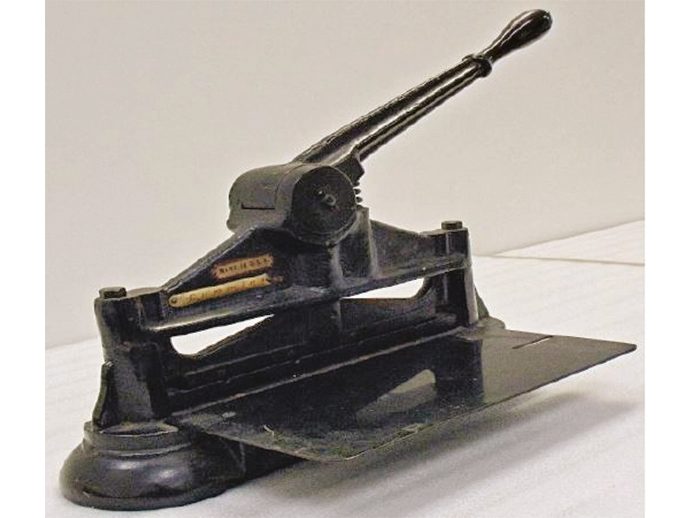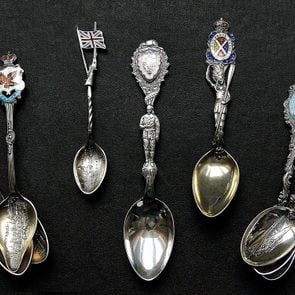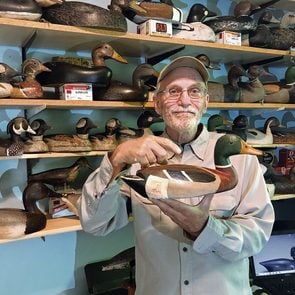Some words just get lost in translation. For example, the Filipino word gigil means that something is just so unbearably cute that you have to pinch or squeeze it. Other words may not get lost entirely, but might get a little fragmented in the process. A prime example would be the word moose.
According to Oxford Dictionaries, moose is a “loanword,” meaning that it was a word that was incorporated into the English language from a foreign language with little or no modification. Many other words in the English language are also loanwords, but moose is a relatively new addition, incorporated from several Indigenous languages in the early 1600s. The timeframe here matters.
Words like goose, tooth, and foot, date back up to a thousand years before moose, when Old English was the only form of English. Back then, pluralization was different; mutations, or sound changes to words, would denote whether or not certain words were plural or singular. As Oxford Dictionaries puts it, a mutation is: “a change in the sound of a vowel produced by partial assimilation to an adjacent sound (usually that of a vowel or semivowel in the following syllable).”
As time wore on, words which used mutations for pluralization were replaced by the more standard modern plural ending (-s) or held onto the pluralizations from their original languages (fungus retained its Latin pluralization of fungi.) Moose fell into the latter category; its origins can be traced back to both the Eastern Algonquian and Narragansett languages, which used neither mutations nor the standard modern pluralizations.
[Source: Oxford Dictionaries]
Now that you know why the plural of moose isn’t meese, put your knowledge of Canadian slang terms to the test.
In the mountainous jungles of northern Thailand, I am being assaulted by a baby elephant. Her trunk has searched my pocket, and, finding nothing of worth, is now bent on stealing the camera hanging around my neck. If this two-year-old were any larger, the mugging would likely succeed, but Pyi Mai is only one metre tall and 230 kilograms. I’ve met larger ponies. Her delinquent trunk does, however, manage to coat my lens with elephant slobber.
I am at Elephant Nature Park (ENP), a sanctuary that is home to 118 elephants, ranging from the adorable to the heartbreaking. ENP has rescued the adults from appalling situations: Some are crippled, some blind; almost all are traumatized. They are now, unquestionably, happier than they have ever been.
In the city of Chiang Mai, 100 kilometres south of ENP, is blessed with exquisite temples and sees as many as seven million tourists a year. ENP is an easy day trip for those who wish to experience living, trumpeting versions of the creatures they’ve seen carved into the ancient architecture here.
Chiang Mai has also become a favourite hub for digital nomads, which was my prime reason for visiting: to see whether it might be a good place to spend a few years writing my next novel. I thought I might check out co-working spaces and cafes. I did not imagine I would be converted into an apostle for an elephant sanctuary.

The woman at the heart of a movement
This institution and its many satellites are the life’s work of Saengduean “Lek” Chailert. Her tireless efforts to improve the lot of Asian elephants turned her into an international celebrity more than two decades ago, despite her humble beginnings; she is from a hill tribe, and was at that time the only female from her village ever to attend school. Chailert was named a Ford Foundation “Hero of the Planet” in 2001. Time magazine declared her a “Hero of Asia” in 2005. And in 2010, then U.S. Secretary of State Hillary Clinton designated her one of six “Woman Heroes of Global Conservation.”
Today, her international non-profit Save Elephant Foundation (SEF) is even more influential. It’s been directly involved in the rescue and rehabilitation of about 200 elephants. During the pandemic it supported nearly 10 times that many across Thailand—helping feed them, offering medical services and improving their living conditions.
Chailert, 61, is known to everyone by her nickname, Lek, which means “tiny” in Thai slang; she is about five feet tall. She has devoted her life to the plight of the Asian elephant, the world’s second-largest land animal. The only one larger is another pachyderm, the African savannah elephant, which belongs to a separate genus. The Asian elephant has smaller ears, its head is topped with two prominent domes, and its trunk has only one prehensile fingerlike extension, instead of two. They are equally magnificent.
Lek is a humble, soft-spoken woman, with angular features and oversized glasses. In English, which of course isn’t her first language, she tells me that her work to save Thailand’s national animal started when she was 16 and in secondary school. An encounter with elephants in the logging industry changed her life.
“When I went to see the elephants work very hard in the jungle, I saw one bull get abused, beaten badly. Every time he pulled a giant log, he is screaming. And when he look at me, the eyes, that screaming noise…” she points to her temple. “It is diffcult to get that out.”
She decided to help him, and returned to the logging site with medicine for the bull’s infections. “I asked the owner, ‘Why the old elephant still work? Why the blind elephant still forced to work? When they will go to rest?’ And the owner said, ‘When they die.’”
Lek’s initial goal was modest: to rescue only that bull elephant. She wanted to bring him to her home and release him, “to let him play with the mud bath, give him his final time with freedom, dignity.” She eventually saved enough money to buy him, but when she returned to the logging site she learned that he had died. Her goal changed: to save all the mistreated elephants in Asia.
“And I decided to create our place, not just to rescue elephants, but to educate people, raise awareness, bring more voice.”
“Bringing more voice” is critical. The United Nations’ Food and Agriculture Organization estimates that Thailand had roughly 200,000 Asian elephants at the beginning of the 20th century, half of them domesticated, half of them wild. Today—mostly due to humans destroying their habitat—perhaps 3,800 captive elephants remain, and most experts estimate some 3,000 roam free.
Working elephants were integral to the country’s teak logging, but when that industry was banned in 1989, their owners looked for a new use for them. They often penned the elephants in camps where tourists could pet and ride them, as well as watch them ride tricycles, manipulate hula hoops and throw basketballs.
Few tourists realize that to make an elephant docile enough to do tricks, you have to break the animal mentally. Called phajaan in Thai, this involves beatings with sharp objects like the bullhook (a steel staff with a hooked end). Torture, essentially.
When the pandemic hit, tourism ground to a halt and owners found themselves with giant creatures they couldn’t afford to feed. Many elephants starved to death. Pyi Mai and another baby, Chaba—her best friend—were captive at a camp where tourists could ride older elephants, and where the animals put on shows including bike-riding. It also had a breeding program, and the mothers were so emaciated they could barely produce milk.
Their owners would certainly not have entrusted them to ENP before the pandemic. Most people in the elephant business have resented Lek’s advocacy; she had drawn international attention to its cruel practices. During the lockdown, however, ENP established a food bank. At one point it was feeding almost 2,000 elephants, more than half of Thailand’s captive population.
The crisis offered an unexpected opportunity: Lek and her people were now aiding businesses that had long considered ENP the enemy. It was a window for diplomacy, and—with gentle prodding—attitudes began to change in the camps.
The two baby elephants and their mothers were at last freed to join ENP, where they have established a small herd. Unrelated female elephants often babysit and develop strong bonds with another elephant’s calf; Pyi Mai and Chaba now have their own pachyderm nanny, D-Max.

Inside the Chiang Mai elephant sanctuary
They also have room to wander, which is essential to an elephant’s health. The 81-hectare sanctuary concentrates on rescuing injured and abused creatures that could never survive in the wild. They have wounds that won’t heal, problems with mobility, incapacitating psychological issues. The aim is to treat their ailments and provide them with a life that’s as close as possible to what they would have experienced had it not been for humans.
Within the Chiang Mai elephant sanctuary, a slow, wide river divides an impossibly green jungle, and in the less wild areas you find odd impositions upon nature: a miniature Stonehenge, for instance, which turns out to be a monolithic backscratching station. The elephants like to rub up against the rough stones as they consume astonishing quantities of watermelons, bananas and sugarcane during scheduled lunches. Other items rarely found in the wild are a massive scale for weighing elephants, and a giant artificial hydrotherapy pool where disabled elephants can work on movement. The weightlessness they experience in the pool is a relief for legs accustomed to supporting several tons.
Tourists are not allowed to touch the creatures (Pyi Mai chose to make contact with me), but there’s often no barrier between humans and elephants. Even the volunteers have only minimal contact; necessary hands-on work is restricted to staff and medical personnel. For a time ENP allowed humans to bathe the animals, but elephants really don’t require bath attendants; they just trundle into the river. The point is to let them be elephants.
A captive elephant in Thailand typically experiences torture and humiliation, gruelling labour and separation from its family. Their complex psychology and social behaviour are callously disregarded. It used to be common, for instance, to take baby elephants into the city as props to aid in begging. Many of these elephants would never see their mothers again. Yet in the wild, a baby is never far from its mother, and a female stays with the matriarchal herd for life.
Lek Chailert is changing this, despite some venomous opposition—including online harassment and even death threats—from people wedded to the old barbaric ways. Her influence has spread across Thailand, and is reaching into Cambodia, Laos, Sri Lanka, Vietnam and Myanmar.
I meet a Nepalese family here who have been running an elephant safari in Nepal; a former volunteer from ENP told them about Lek’s revolution, and they want to convert their operation to an ethical sanctuary. They’ve come here to see these principles in action.

Passionate volunteers
ENP is not restricted to pachyderms alone. The team also cares for 100 water buffalo, 150 wild boars, 130 cows, 30 goats, a “kingdom of cats”—approximately 2,000 of them—and 650 dogs, 50 of them disabled, many rescued from Bangkok during severe floods in 2011.
The sanctuary has three veterinarians who specialize in elephants, six general vets and a posse of veterinary nurses. They’re experimenting with elephant prosthetics and other devices: I’m shown a fibreglass contraption that they hope will stabilize an injured knee. ENP is working on a fully equipped elephant hospital and plans to complete it in 2024.
The volunteers I encounter—from Australia, the United States and the United Kingdom—are impressively cheerful, and range from their teens to their 90s. Everyone dines communally in a rustic open pavilion, and I join them for lunch, an outdoor buffet featuring Thai vegan cuisine of the highest order. They tend to have rapturous stories about a near-religious conversion, about how an encounter with Lek and her organization caused them to reorient their lives towards an unexpected goal: elephant rescue.
I meet Lee and Roger Denison from Wokingham, U.K., who first visited ENP in 2018 just after Roger retired at age 60. This is their third time volunteering; they’ll be here for two weeks. Much of the work while I’m here involves cleaning the banks of the river in the wake of the worst flooding in at least 20 years. But the tasks are numerous and diverse: preparing food for various species and presenting it to them, mucking out stables, helping build roads.
Between work sessions, volunteers relax with the elephants. “It’s going to be part of our holiday vacation every single year now,” says Lee Denison. “We’ve even made provisions in our will for ENP.”
Kathy Snyder is a volunteer from Redding, California; this is her fifth time at the sanctuary, and she’ll be staying for a month. “When I first came here, Lek said, ‘I hear you’re a nurse. I have a sick elephant that needs medical care. Can you help me out?’” That was six years ago. Since then, caring for elephants has been one of Snyder’s chief joys in life.
Snyder, who has volunteered at several other sanctuaries around the world, stresses that she’s a “human nurse” but that the skills are transferable; wound care, for example. Moreover, she says, most mammals “have the same bones and organs; they’re just bigger or smaller or in a different spot.”
In 2018, Snyder helped with laser treatments for an elephant named Dalah. Before she was rescued, Dalah’s legs had been badly wounded during a forced breeding session and she had also suffered organ damage. Forced breeding sometimes involves chaining a female by all four feet. The male elephant, typically between the ages of 10 and 15 and experiencing a spike in testosterone that increases their volatility and aggression, is jabbed with a bullhook until he mounts the female.
Despite what the team accomplished for Dalah’s legs, she did not survive her internal injuries. The hydrotherapy pool is named in her memory.
“I make it a point to come here as often as I can,” says Snyder. “It gets in your heart. You can’t stay away.”

Agents of Change
During my visit, I’m squired around by the foundation’s project director, Ry Emmerson, a cherubic ex-cop from northern England (whose pronunciation of “elephant” is “elly-phant”). Now 35, he was once a corrections officer at a high-security prison for men, including those convicted of sex offences. “Very challenging and risky people,” he says. “Part of my job was talking with offenders about why they committed their offense in order to better understand how to help them reduce their risk of offending in the future.”
It was good training for his current job, which involves convincing people in the elephant business to change their practices.
How did a British ex-cop end up in the jungle? In 2012, when Emmerson found he was no longer satisfied with his work, he took a career break and began travelling, often volunteering at animal rescue operations in various countries. In Thailand, he experienced ENP with awe. Then, seven years ago Emmerson was hired as project director on an elephant sanctuary that Lek’s organization was building in Myanmar, Thailand’s neighbour to the west.
With the ongoing political turmoil in Myanmar, the sanctuary proved unworkable, and he found himself helping with other projects supported by SEF. “My role now includes a bit of everything,” says Emmerson, the only foreigner working at the office in Chiang Mai. That includes project management, handling international media and coordinating Lek’s schedule. And, crucially, when an elephant organization approaches SEF because it wants to be more ethical, Emmerson is the one who goes in to help them change.
“I have to go places where I see elephants in horrific conditions,” says Emmerson. “In Myanmar, I met with a family whose business was poaching elephants. You have to control yourself as you listen to what they’re telling you. Because if you start to cry when you hear how brutal what they’re doing is, they’re not going to tell you.”
Later I learn that today, most baby elephants are born into captivity as a result of forced breeding. But at one time, trapping elephants often involved slaughtering elderly herd members and trafficking the younger ones to entertain tourists. Even the most hardened cop would likely have a hard time not being reduced to tears by what Emmerson deals with. Just visiting ENP is emotionally complicated. It’s wonderful to get close to these animals, but you’re always aware of why they’re here.

The way forward
Emmerson takes me to meet the baby hellraisers, Pyi Mai and Chaba. “They’re inseparable,” he says. “Everywhere they go they create chaos.” When he greets Pyi Mai, he puts her trunk up to his mouth and blows into it, as if playing a didgeridoo. Apparently, an elephant can tell a lot from your breath. “She wants to know, ‘Where have you been? Which other elephants can I smell?’”
We go for a walk to meet Mae Sri, who’s in her 70s and dotted with bluegreen spots, which are wound treatments. Until she was rescued in 2018, Emmerson tells me, Mae Sri had been abused in the riding industry.
“When she came here she was skin and bones, with many open wounds.” She has arthritis and when she falls, a truck-mounted hydraulic crane must help her up. The sanctuary has built her a special “bed,” a sloping sand bank, so that she doesn’t have to lie down: She simply leans at a 45-degree angle.
Every elephant I encounter is accompanied by a dedicated mahout (elephant handler). When you rescue an elephant, you generally have to rescue their mahout—they come as a unit—or pair the elephant with a new handler. Hence, ENP houses an entire community of mahouts, often refugees from Myanmar or hill tribesmen. The park employs their wives in traditional roles—working in the kitchen, or housekeeping—and gives scholarships to their children.
Mahouts have to be convinced to change habits passed down for generations. “They have been taught that if you don’t chain an elephant, it will kill you; that if you don’t use the hook, it will kill you,” says Emmerson. Bullhooks are routinely used to inflict pain, enforcing behaviour. The hook is jabbed into a sensitive area, often behind the ear.
There’s no question that elephants can be dangerous, especially when tormented. Males, generally far more aggressive than females, can pick up a large rock with their trunk and throw it at you with the accuracy of a talented baseball pitcher. Nevertheless, the most effective way to manage elephants—and the only decent way—is with positive reinforcement: You reward good behaviour rather than punishing bad.
The inhumane elephant camps for tourists have to be taught this approach, and to be shown that, thanks to the growing demand for ethical tourism, there are alternatives to brutality.
ENP is proof tourists will gladly pay for the chance to observe elephants happily being elephantine. But Emmerson is realistic. “Elephant owners in Thailand are not changing overnight because they suddenly love their elephants. It’s about the business model.”
The economics were rendered much more difficult, of course, by the pandemic. ENP relied upon various ingenious programs to generate money in the absence of tourism. It developed a system to foster an elephant from afar, and the option to remotely present an elephant with a birthday “cake” (a whimsical fruit arrangement). It may be your elephant-besotted daughter’s birthday, but it’s the excited elephant who gets the cake; your daughter gets the video. This ritual was so popular that ENP has maintained it.
These programs were devised, however, as stopgaps until the tourists returned, and that remains an uncomfortable paradox: ENP is devoted to saving elephants from exploitation by tourists, but the hard financial truth is that keeping these creatures alive, even in a rigorously ethical sanctuary, requires some form of tourism. It’s not a question of ending elephant tourism, but reinventing it.
My last experience at the Chiang Mai elephant sanctuary is watching a glorious daily ritual late in the afternoon. The elephants swim down the river into camp to spend the evening, led by the precocious 11-year-old Kham La, who has somehow taken charge of companions at least twice her age. An overhead complex of viewing platforms, the SkyWalk, allows visitors to observe the herd climbing onto the banks, trumpeting and rolling in the mud. They’re clearly enjoying life. If tourism is a necessity, then this is how it should be done.

Emmerson is unsurprised by how ENP has affected me. Even after decades of animal activism I don’t have the stomach for stories of abuse, and it shows in my face—as does my admiration for the wondrous things they’re accomplishing here. He suggests I visit their project just outside of Siem Reap in Cambodia. Even before the pandemic, it hadn’t been drawing sufficient visitors and volunteers—despite being less than a two-hour drive from the Angkor Wat temple complex, the nation’s most popular tourist destination.
Cambodia Wildlife Sanctuary sits in a vast swathe of jungle, 13,000 hectares guarded by ex-poachers converted to good guys. Only three of their many rescued animals are pachyderms, but one of them is Kaavan, infamously known as “the world’s loneliest elephant.” Kaavan had been chained in a miserable zoo in Pakistan; a mass Twitter protest in 2016 caught the attention of the American singer Cher, who wrote “Walls,” a song about his suffering, and spearheaded a campaign for his release.
This is how it starts. I had come to Chiang Mai to scope out apartments and tour the temples; I was lured to Elephant Nature Park because, like so many people, I care about elephants; and now I’m catching a flight to Cambodia to feed Kaavan.
I know that when I return to Canada, I’ll talk about my experience, loudly and widely, to anyone who will listen. I will, like almost everyone who has encountered Lek Chailert and her crusade, “bring more voice.”
Next, read up on the incredible efforts to save New Zealand’s kiwi bird from extinction.
Lately, when “Mom” pops up on my call display, I look at my phone, sigh heavily and think, “What now?” At almost 80 years old, my mother seems to have more tech gadgets than I do, and yet she’s hopeless when it comes to basic troubleshooting. Whether I like it or not, I am her dedicated tech support. I field calls about her laptop, smartphone, printer, scanner, universal remote, Wi-Fi network, Bluetooth speaker and ultrasonic toothbrush, just to name a few. Twenty-four hours a day. Rain or shine.
If you have been similarly conscripted, here are some tips from the trenches:
Always take her call. I know, I know, it can be painful, but you have to trust me on this and pick up. She is your mom, and she’ll play that card. I usually get a “Craig, I am your mother.” Plus, if she detects even the slightest hint of my exasperation, she hits me with “I changed your diapers!” Well, Mom, being your personal Geek Squad is a crappy job, too!
Don’t troubleshoot in front of co-workers. Over the years, Mom and I have developed a familiar, “unfiltered” tone when we talk to each other. My side of a typical call starts with “Yes, Mom?” and quickly spirals from there to “You can’t do what?” to “I would love to help, but I don’t think ‘thingamajig’ is a $%&# technical term!!!” Such talk, while often justified, doesn’t go over well in an open-concept office. Your colleagues will think you’re The. Worst. Son. Ever. To avoid raising any eyebrows, take the call from the nearest supply closet. (Pro tip: if you need something to scream into, a roll of paper towel works great!)
Share the burden. The next time Mom hands you her smartphone to “figure out,” take a proactive step by creating a new contact called IT Emergency Helpline and encourage her to use it. But instead of inputting your number, use your sister’s. (Sorry, Krista!) It’s about time she stepped up. Sure, she may be balancing three kids and a new job, but since when is that a Get Out of Jail Free card from helping Mom figure out where her Spider Solitaire icon disappeared to? (I have a life, too, Sis!)
Help mom’s wi-fi help her. Recently, while taking a break from looking out her front window, Mom managed to locate that one corner of her home that has a weak Wi-Fi signal. What prompted her to use her tablet in the furnace room I’ll never know, but she sure as sugar called me afterwards to complain about it…followed by an update on her neighbours. Faster than Roto-Rooter, I was over fixing her network and decided to rename it. I felt “Linda Wi-Fi” was boring. Thanks to me, folks within a five-house radius have seen “Pick Up After Your Dog Wi-Fi,” “Mow That Lawn Dammit Wi-Fi” and “Your Powder Room Needs Blinds Wi-Fi!”
Avoid emojis at all costs. Finally, a word of caution. I mistakenly introduced Mom to emojis thinking they would liven up our otherwise mundane text exchanges. At first, I needed the Rosetta Stone to decipher Mom’s messages. For instance, on one occasion I wasn’t sure if she was describing her garden or curious about medical marijuana. But things turned really awkward last August after Mom got home from the local peach festival. Her texts describing plump, lip-smacking peaches still give me nightmares.
Next, check out these hilarious tech tweets everyone can relate to.

The Origin of Ramen
You may think of ramen as the instant packets beloved by university students. But the best versions of this noodles-and-broth dish, with toppings like roast pork, seaweed, fish cakes, shiitake mushrooms, bean sprouts and eggs, are being noisily slurped up at all hours in ramen joints around the world.
And the origin of ramen is a fascinating story. Chinese immigrants brought the wheat-noodle recipe to Japan, according to historian and ramen expert George Solt in The Untold History of Ramen: How Political Crisis in Japan Spawned a Global Food Craze. In the 17th century, a scholar from China told his employer, a Japanese feudal lord, how he could make his noodle soup taste better: by topping it with pork and vegetables.
By 1910, the first ramen shop in Japan, Rai Rai Ken, was serving the dish to Tokyo diners. Chefs combined noodles in a salty broth topped with other foods. The dish was called shina soba in Japanese (“shina” is an archaic Japanese word for “China,” while soba are thin buckwheat noodles). But then the Japanese pronunciation of “lamian,” the Chinese word for the soft wheat noodles, evolved into today’s “ramen.”
World War II interrupted its early popularity. Food shortages led the Japanese government to ban anything considered a luxury, and that included ramen. When the seven-year Allied occupation of Japan began in 1945, the United States continued to limit the sale of ramen there due to a shortage of wheat flour. But fearing that prolonged food shortages might lead the population to gravitate toward Communism, the U.S. began to import American wheat into Japan. That, plus a shortage of rice, fuelled demand for ramen.
What About Instant Ramen?
In 1958 Taiwanese businessman Momofuku Ando created a dehydrated version in square packets that only required putting the dried noodles in a bowl and adding boiling water; Styrofoam cup packaging debuted in the 1970s. Today, there are two museums in Japan dedicated to Ando’s creation.
Decades on, Ando’s forename also inspired the latest step in the dish’s evolution in North America. In 2004, Korean-American celebrity chef David Chang opened Momofuku Noodle Bar in Manhattan, where patrons can enjoy steaming bowls topped with smoked pork belly, poached eggs and bamboo shoots for US$21. Chang’s restaurant has helped change the perception of ramen from a cheap packaged food to a complex and indulgent dish.
Ramen Around the World
Hungry visitors to ramen shops can typically choose from four broths: shoyu (soy-sauce based), miso (made with fermented soybean paste), shio (or “salt,” often with a chicken or fish base) or tonkotsu (rich and fatty, made from pork). The broth gives ramen its umami, or pleasant savoury taste.
You can find ramen shops in cities all over the globe, from Munich to Vancouver and from Sydney to Paris. But Tokyo is definitely the world’s ramen capital: It has well over 10,000 shops.
Whether you choose instant or gourmet, shio or tonkotsu, shiitake or fish cakes, ramen is a heart- (and belly-) warming dish with a story that connects time and place. To love it is to slurp it. Itadakimasu—bon appetit!
Now that you know the origin of ramen, check out the fascinating history of the taco.
My exercise regimen now includes 40minutes of vigorous dance in the kitchen just before bedtime. I leap into the air like a youthful Nureyev, performing a grand jeté to the left and then one to the right. Next it’s tap work, madly stamping the ground like a frenzied Fred Astaire.
The cause is a double insect infestation. Pantry moths fill the air; cockroaches scurry across every surface. Both are common here in Australia, particularly during the hot summer months. I am determined to win my battle against them.
I say the cockroaches “scurry,” but that’s not the right word. Rather, it’s a brisk, purposeful walk. They have no fear; they own this place. From the dignified manner of their perambulation, I assume they’ve already contacted my bank and taken over the mortgage.
I have tried traps, of course, which the cockroaches regard as mobile housing, dotted around the place for their convenience. I have tried insecticide, which has a worse effect on me than on them. There are so many cockroaches, I wonder if they’d mind fetching my asthma puffer from my bedroom drawer before I spray.
More recently, I’ve considered contacting Kim Jong-un and arranging a nuclear strike, but I’ve heard cockroaches can survive that, as well. The pantry moths are similarly oblivious to all the products that promise their eradication. Chief among them is the moth trap—essentially a sheet of sticky paper impregnated with female pheromones. It’s like an insect version of a nightclub.
The problem: While it works on 95 percent of the males, the ones that survive and breed with the females are, of course, the strongest ones. My pantry is now home to accelerated evolution. Wait three weeks and the moths will be the size of bats. Wait three months and you’ll open the door to be greeted by the dragons from Game of Thrones. And so I’m left with my leaping and stomping dance routine. I pluck the pantry moths from the air with my bare hands; the cockroaches I dispatch with my feet.
For reasons that are unclear, the insect infestation is my fault. Or at least my responsibility. “It’s repulsive,” says my wife, Jocasta. “When are you going to do something about it?”
What she means is: “When are you going to hire a real man to solve the problem?”
In fact, I’ve already called a real man, a professional pest controller, only to be told a visit will cost $365. It’s a figure that instantly brought new energy to my dance moves. I’m now more like Mikhail Baryshnikov with a side order of Jackie Chan, leaping from one side of the kitchen to another, a flying machine of death. I go to bed each night panting with exhaustion and calculating the bugs’ nightly losses against the breeding that will inevitably occur overnight.
Female cockroaches can produce eight egg capsules in a lifetime, each holding as many as 40 eggs. How many is that? Just multiply eight and 40 and you’ll get the answer: Eww!
Actually, that’s nothing compared to a female pantry moth, which lays 400 eggs at a time. They take as little as seven days to hatch. This is too much, even for Baryshnikov. I’ll need a whole corps de ballet.
Apparently the pantry moth smuggles itself into your home through your shopping, so by freezing all your dry goods, you can kill off the eggs. Not so practical, though. Worse, who knew that flour, rice, almond meal and the rest of it are full of moth eggs? I never want to eat anything ever again.
The only thing I can do is wait. Maybe Kim Jong-un will destroy all life on the planet, proving science wrong by killing the cockroaches, too. Or maybe I’ll get over my reluctance to spend $365.
That’s unlikely. So wish me luck.
Next, read Richard’s hilarious take on housekeeping as a fitness regimen.
No doubt you’ve come across a Snickers, Milky Way or Hershey bar with a weird bit of white dust or an off-coloured section. Chances are, you’ve questioned exactly how long that chocolate bar has been sitting on the convenience store shelf. Maybe you’ve even wondered if it was safe to eat. Well, it turns out that dusty appearance is down to a process known as “chocolate bloom.” Here’s how it works.
What is chocolate bloom?
The explanation for chocolate bloom is simple food science—it happens when the fat in chocolate separates from the rest of the candy. When chocolate is left in a warm place and melts, the fat in the chocolate (also known as the cocoa butter) will separate from the rest of the ingredients as it cools and reforms. Then, as the fat rises to the surface, it creates that white, dusty film.
In a similar process known as sugar chocolate bloom, the sugar will crystallize due to excess moisture. When that happens, you’ll typically see a speckled appearance on top of the candy bar.
Is bloomed chocolate safe to eat?
The short answer is yes, it’s safe. The taste may end up a little off, but it’s edible nonetheless.
If you’re uneasy about eating bloomed chocolate, but don’t want to waste the candy, use it for baking. Drop ’em into candy bar cookies, crush the candy bars to top chocolate-covered espresso beans or stir pieces into chocolate bar brownies.
Next, find out which expiration dates you should never ignore.
Welcome to my worst nightmare: I prepared my favourite dip for a potluck party. As I’m getting ready to leave, I discover my beautifully soft baguette became rock hard overnight. My mind is racing with all the ways I can repurpose a stale loaf of bread by making croutons or breadcrumbs, but I need ready-to-eat slices of bread now!
This nightmare scenario doesn’t have to end with buying a new loaf on my way to the party because we know a hack for making stale bread fresh again. It really couldn’t be easier! This simple technique will soften even the crunchiest of bread, reviving that foregone loaf into like-new slices of bread again. Once you know how, you’ll want to tell your friends—you’ll be the lifesaver of the party!
How to Make Stale Bread Fresh
What you’ll need:
- One loaf of rock-hard or stale bread
- An oven
Step 1: Wet the Loaf
I know this seems counterintuitive—won’t wet bread be soggy?—but trust us: You actually do want to stick that loaf of bread underneath the kitchen faucet. Turn the water on so it’s running in a slow, steady stream (it doesn’t matter if the water is hot or cold). Position the cut side of the loaf away from you and run the stale loaf of bread under the running water. The goal is to moisten the crust without getting too much water on the interior.
Step 2: Bake It
Set the oven to 300-degrees F and place the moistened loaf directly on the rack. The low temperature will heat the water, causing the bread to steam inside the crust. After 5 minutes, give the loaf a gentle squeeze. You’re looking for a crunchy-crusted bread that has some give when you compress it. You may need to bake the bread for up to 15 minutes, depending on the size of the loaf and how much water it absorbed.
Step 3: Enjoy Your Like-New Bread!
Just like that, your bread is crunchy on the outside and soft on the inside!
Now that you know how to make stale bread fresh again, you’ll never have to throw away another loaf! Find out more of our best cooking hacks of all time.

Got a Chipped Windshield? Here’s What to Do Next
Sadly, a chipped windshield is part of life as a vehicle owner. Windshields get chipped and cracked all the time, and although they’re often inopportune, they can’t be neglected and should be attended to in short order. (Here are more essential car maintenance tasks that are often overlooked.)
Even though they may seem minor, small stone chips can quickly develop into a costly repair job. Chips grow when pressure is placed on your windshield. Pressure can come from a variety of sources, even something as minor as taking your car though the car wash or when changes in temperature occur. And, once they grow into a crack, they can no longer be fixed and your windshield will need to be replaced.
“Most insurance policies will cover the cost of stone chip repairs without impact to your policy rate,” says Wayne Ross, an insurance expert at Aviva Canada. “So people don’t need to be afraid to contact their insurance company about it.”

Being proactive and repairing a chipped windshield can save drivers a significant amount of money. A windshield replacement can cost anywhere from a couple hundred dollars to $1,500, and therefore, fast action is crucial.
A cracked windshield is also a safety hazard. If the glass is cracked it could break and impact your ability to drive safely. What most people don’t realize is that the windshield is part of the structural framework of the vehicle. A cracked windshield has a greater chance of shattering or causing an accident.
Ross suggests taking the following steps if you notice a stone chip in your windshield:
- Contact a reputable and licensed supplier for glass repair. Many have mobile services and they will come to you.
- Talk to your insurance company and find out if the repair is covered.
- Be aware of insurance fraud scams. Never give your insurance information to anything less than a reputable repair shop with a long standing presence. Temporary repair stations should be avoided.
By being proactive you’ll save money, keep the inconvenience to a minimum, and—most importantly—stay safe.
Now that you know why you need to repair a chipped windshield quickly, find out what these strange car noises mean, according to a mechanic.
Our 1975 Buick LeSabre convertible has been with us since July 1982.
We had flown to our honeymoon destination, beautiful Victoria B.C., where we purchased the car as soon as we spotted it in a dealer’s lot. We had been looking for this type of convertible for quite some time and were really excited by our find.
While driving back to Alberta through the mountains, the car began to smoke, heat up and lose power. After we drove into a trucker’s pull-out, we talked with a trucker who told us about a town with a transmission place, as well as another repair shop owned by a friend of his, not too far down the road. We coasted gently down the hill and rolled into the transmission place.
The vehicle had been certified as serviced from the dealer that sold it us, just a week before. Of course, this shop owner said, “The transmission is shot. You will need to replace it.”
“No way!” was my reaction, so we limped off to the small repair shop owned by the trucker’s friend and consulted with him. He laughed, changed a filter, filled up the transmission fluid and we were off! Today, the same transmission is still going strong.
Psst—here are 20 secrets your mechanic won’t tell you.

In 1987, as we were travelling across Canada, the heated back window suddenly shattered as we were pulling into Dryden, Ontario. After days of rain, we hadn’t wasted a minute in putting the top down once the sun finally came out. In the meantime, our camera bag had slid forward into the trunk area and, as the top folded down over the bag, “POP” went the window!
We were devastated, but all we could do was repair it the best way we knew how—with good ol’ duct tape. We carried on along our route to the eastern seaboard, then back across the northern states. Our longest one-day run was approximately 1,126 kilometres from Bemidji in Minnesota, to Bladworth, Saskatchewan, as we strove to make it there for a favourite aunt’s birthday. Along the way, while on the freeway, a sheriff’s car pulled up alongside us, eyed us up and down, then motioned, let’s roll! We followed him for a while, running our 455-four barrel as it was meant to cruise, while literally following the law.
No doubt, it’s always safer to respect the speed limit, as I came to appreciate in our own city of Grande Prairie, Alberta, one beautiful summer evening. It happened in the most unlikely location—a quiet side street in an industrial park. An RCMP officer in training pulled us over and issued me a ticket for going over the speed limit, by just a small amount. She was very professional, very considerate and soon-to-be, very surprised! I was used to driving a basic pickup truck that you had to hit the gas hard to get rolling decently. Out of habit, I used the same technique with the LeSabre as I pulled away from the front of her police car; the tires squealed and rubber began to smoke. Uh oh! She just smiled and wagged a finger at us as we sheepishly drove off down the road. Phew! Just goes to show that driving such a powerful car can turn into an unexpected adventure if you’re not careful.
Recently, we decided to give our LeSabre a total overhaul in our shop on the farm, with the intention of putting her back on the road again next spring. She is still a pleasure to drive, so comfortable and always has lots of power to spare!
Next, can you help reunite this couple with their beloved honeymoon car?

When I earned my Collector’s Badge as a 12-year-old Boy Scout in Prince George, B.C., I had no idea it marked the start of a journey that would last the rest of my life. It all started when I requested stamps that were on the envelopes we received from friends and family. I began organizing them into a collection and worked on it periodically, whenever the weather was inclement.
Six years later, while attending college, I joined the Prince George Stamp Club as its youngest member. At each monthly meeting, some time was devoted to show-and-tell where I presented my latest discovery, only to be disheartened when other members inevitably said, “Oh, I have five or six of those.” It took me more than a year—and countless hours of fun at the local stamp shop—before two of my discoveries were met with dead silence at show-and-tell. I had found two stamps, full of holes, that no one else had in their collection.
A Passion For Perfins
One of the stamps had the initials “CPR” perforated into it. My paternal great-grandfather, my grandfather and one uncle were lifetime employees of the Canadian Pacific Railway, so there was an instant family connection. It was then that I decided to focus my collecting solely on “perfins,” as these stamps with perforated initials were known. At an average cost of five cents each, they fit my college budget well. Even today, common perfins are quite affordable at around 25 cents each.
Recognizing that perfins were unusual, I promptly got my hands on a reference book, Canadian Stamps with Perforated Initials – 3rd Ed., produced by the British North America Philatelic Society (BNAPS), a group that I joined in 1973. I learned that stamps were perforated with the company’s initials to reduce pilferage, a feature achieved today by company postage metres.

A Stamp Collector’s Road Trip
Six years after leaving college, I realized that I had never been east of British Columbia. So, I embarked on a solo camping trip from Vancouver to St. John’s in 1978. To give the trip some focus, I visited companies that used perfins to see if they still had their perforator machines. As luck would have it, the first individual I spoke to was the vice president for the CPR’s Prairie Division in Winnipeg, who’s first job had been perforating their stamps! Even with his help, we were unable to find the perforator he had operated. Later in the trip, I managed to locate several machines and was able to study how they operated.
When the road trip concluded, I settled in Calgary, where I teamed up with another avid perfin collector, Gary Tomasson. Since 1980, he and I have produced further editions of Canadian Stamps with Perforated Initials and written numerous articles on company and government perfins.
The two perfins I started with have expanded into a collection of more than 10,000 mounted stamps, in more than two dozen binders and several hundred more still attached to their original envelopes. Now that I’ve recently retired, I have a lot more time to have fun chasing stamps full of holes.
The latest edition of Canadian Stamps with Perforated Initials by Jon Johnson and Gary Tomasson is free to download.
Next, check out 20 mind-blowing artifacts you’ll find in Canadian museums.





























